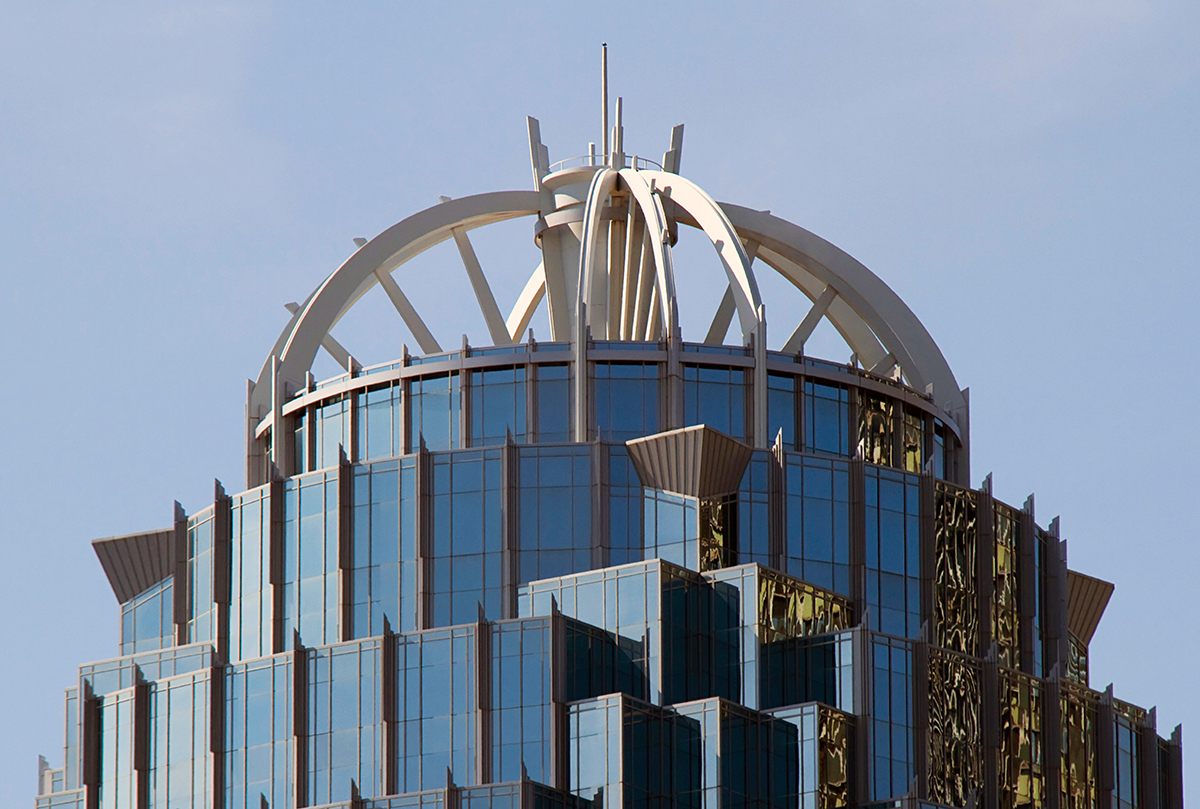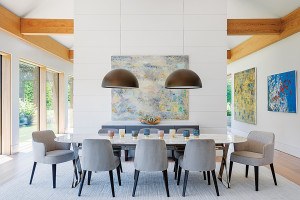Why Is Boston So Ugly?

Remember the crown that Tom Menino picked to top 111 Huntington? It’s there for a lifetime. (Photograph by tony higett on flickr/creative commons)
Thirty Dalton Street, a slim residential tower being built at the corner of Dalton and Belvidere in the Back Bay, is destined to rise 26 stories on a sliver of land just behind the Christian Science Plaza. It announced itself one day last fall, when a tiny piece of the future tower was erected on the site, made of that bluish reflective glass you see on literally every façade in Boston—the kind that unfortunate birds mistake for sky—and standard-issue metal panels, probably labeled “pewter” on the office sample. Formless, indistinct, ugly: another Boston skyscraper inspired by a Holiday Inn in Topeka.
The forest of elevator cores sprouting up around town tells us that we’re living in a once-a-century moment—a sugar rush of development unseen here since our parents’ parents’ time. But the dirty little secret behind Boston’s building boom is that it’s profoundly banal—designed without any imagination, straight out of the box, built to please banks rather than people. Renderings of 30 Dalton show how its panel-and-glass motif will create a relentless gridded box of windows from floor to sky: Click, copy, and paste. A few weeks after 30 Dalton’s miniature arrived on the site, the backhoes arrived to carve a foundation out of what had been a parking lot. A few feet away, the old brownstones of St. Germain Street—the ghosts of Boston’s long-lost architectural ambitions—hunkered down in 19th-century resignation.
Technology and innovation were supposed to power Boston’s next great age, but judging from our skyline, both were instead harnessed to spit out blank, emotionless towers. If we continue to do what we have done—what we are still doing now—then our negligence, and the passivity of a generation of builders, architects, and city planners, will be responsible for the most unremarkable design period in Boston’s history. For years, few have cared that our buildings look more like executable spreadsheets than good citizens.
It doesn’t have to be this way.
Marty Walsh was a builder all his life, but last fall, after the builder had become mayor, he began to look at Boston’s buildings in a different way. He and a handful of city officials, including the chief planner, Kairos Shen, toured New York City to check out its architecture. In that metropolis to the south, Walsh saw a city that consistently kicks our architectural asses: exciting building everywhere, much of it speculative—created by developers who relish taking financial and creative risks. Imaginative planning initiatives had energized sections of New York, such as the High Line, an elevated train viaduct turned into a highly choreographed park that draws crowds of tourists and New Yorkers alike. Why wasn’t Boston like that?
Lovely urban buildings get built all the time—just not here. In Philadelphia, elegant glass towers by American Institute of Architects gold medalist César Pelli are rising up along the Schuylkill River. In Chicago, MacArthur fellow Jeanne Gang recently completed one of the most compelling residential towers in the United States, with a hypnotic, undulating façade. Closer to home, in Somerville’s Union Square, a city-run design competition awarded the area’s revitalization project to a major Chicago developer who assembled a dream team of small local and major national architects (including Gang) to rebuild the neighborhood incrementally. Also across the river, an enormous biotech complex is going up near Central Square. Designed by Maya Lin, the architectural prodigy most famous for the Vietnam Veterans Memorial, and Toshiko Mori, former chair of Harvard’s architecture school, the remarkable construction for Novartis features a fascinating “floating” stone façade in an irregular pattern. It’s traffic-stopping architecture. It’s a wow.
When Walsh returned from his New York trip, he sounded like an architectural evangelist. In a speech to the Greater Boston Chamber of Commerce in December, he passionately advocated for better, more-compelling architecture. “Too often, in recent decades, new buildings have been merely functional,” he said. “I believe Boston can do better. We should aim for world-class design. Our historic buildings reflect our unique past. New buildings should project the values and aspirations of our growing city. We can balance the old and new. And we can do it with imagination.”
Still, our city lacks a consistent language to express its desires. We fumble for the right words because design has so seldom been part of the discussion about development. We don’t have a vocabulary to describe it. And the problems with turning this ugly city into a 21st-century design mecca run far deeper than that: It’ll take more than just the mayor’s vague notion that design matters. The rest of the city needs to get onboard, too.
The irony is that Boston is famous for turning out great architects. With four superb architecture schools within 5 miles of one another, we have an embarrassment of innovative designers, many of whom stick around after their education—alas, most of them stick around to teach, not to build. Still, Boston is now home to a handful of world-class architecture firms—companies employing between 20 and 50 people—that are designing beautiful, exciting buildings. And they’re getting built, too. Just not in Boston.
That’s because our most vigorous design firms—including Hacin + Associates, DesignLab, Merge Architects, NADAAA, Anmahian Winton, and Machado and Silvetti—lack the capacity to take on Boston’s biggest projects, like 30 Dalton or the million-square-foot Millennium Tower. That hasn’t prevented these firms from taking on big jobs in other cities: When they need to scale up elsewhere, they partner with companies that have tower-building knowledge. Here, however, that kind of collaboration isn’t happening. Boston’s big local firms work cheaply, charging very little for their services and undercutting everyone else. To make ends meet, they rehash existing ideas instead of approaching each project as a unique challenge: Click, copy, paste.
But that shortsightedness is leading to unintended consequences. Now developers from every corner of the globe are salivating over Boston—precisely because this may be the last place in America where you can recycle entire drawing sets and still make serious dough. Newcomers like Sweden-based multinational Skanska and Oregon-based Gerding Edlen are delighted to cater to our bargain-basement design standards—dumb design means near-instant cash. And Skanska is suddenly king of the waterfront: They’re building three blank-faced, forgettable boxes there right now. Some one million square feet made of glass, glue, and drywall.


